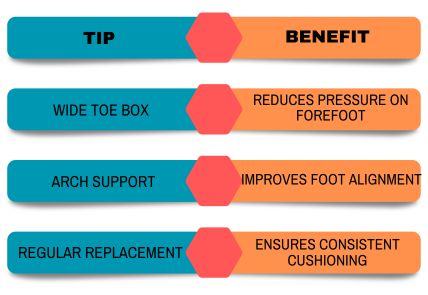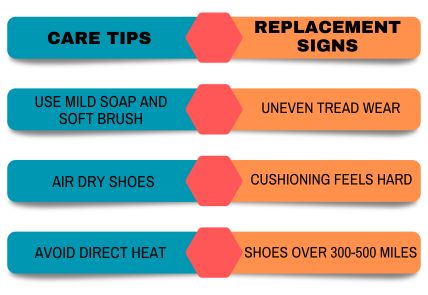Running shoes for metatarsalgia provide improved cushioning and support to alleviate forefoot pain. They are designed to reduce pressure on the metatarsal heads.
Runners experiencing metatarsalgia need footwear that can help distribute their weight more evenly during a run, minimizing the impact on their feet. The right pair of running shoes can make a significant difference, offering relief from discomfort and improving overall foot health.
With the vast array of choices on the market, it’s important to select shoes that combine a roomy toe box, ample cushioning, and proper arch support. These features work together to help prevent additional stress on the metatarsals. Whether you’re a casual jogger or a seasoned marathoner, understanding the importance of proper footwear is key to maintaining your running routine free from pain.
Introduction To Metatarsalgia
Metatarsalgia is a condition that affects the ball of your foot. It causes pain and discomfort. People with this issue feel like they are walking on pebbles. It’s common in athletes and those who wear tight shoes.
The main symptoms include sharp pain, burning, and aching in the ball of the foot. You might also feel numbness or tingling in your toes. These signs can get worse when you stand, walk, or run. Resting helps in reducing the pain.

Importance Of Proper Footwear
Choosing the right running shoes is important for those with Metatarsalgia. Good shoes can reduce foot stress. They provide essential support to the metatarsal bones. This helps in managing pain effectively. With proper cushioning, these shoes can alleviate pressure during movement. As a result, they improve foot health and comfort.
Shoe features like arch support and wide toe boxes are important. They can prevent further foot damage. A well-chosen pair absorbs impact and distributes weight evenly. This is key to minimize discomfort while running. Remember, the right footwear is a step towards pain-free running.
Features To Look For In Running Shoes
Choosing running shoes for metatarsalgia requires attention to detail. Look for shoes with ample cushioning to absorb impact and reduce pressure on the forefoot. This cushioning should be present in both the heel and the forefoot regions for balanced support. Additionally, shoes must provide arch support to help distribute weight evenly and alleviate stress on the ball of the foot.
Sole flexibility is also important. Shoes with soles that are too rigid can worsen pain. Instead, opt for a sole that allows natural foot movement. This flexibility helps in promoting a proper gait cycle, which can be beneficial for those suffering from metatarsalgia.
Lastly, proper fit cannot be overlooked. Shoes that are too tight or too loose can lead to increased pressure on already sensitive areas. Ensure there’s enough room in the toe box to prevent compression when the foot lands during a run. A snug fit around the midfoot and heel is also important for stability and to prevent unnecessary sliding.
Top Running Shoes For Metatarsalgia
Individuals suffering from metatarsalgia need shoes that offer exceptional support and cushioning. The right pair can make a significant difference. We’ve looked at various models and compiled insights on their performance.
| Model | Pros | Cons |
| Asics Gel Nimbus 22 | Superb cushioning, Gel technology for shock absorption | May be pricey for some budgets |
| Brooks Ghost 13 | Smooth ride, great for long distances | Not the best for tight turns |
| Hoka One One Bondi 7 | Thick sole for maximum cushion, breathable upper | Bulkier design, less ground feel |
| Adidas Ultraboost 20 | Responsive Boost midsole, stylish | Heavier than some competitors |
Each shoe model presents unique benefits to runners. Your personal preference and foot type will guide your choice. Always consider fit, comfort, and how the shoes feel on your runs.
User Experiences
Many runners with metatarsalgia have found relief through the right footwear. Success stories often highlight the importance of cushioning and proper fit. They share their journeys, detailing the transition from pain to comfort. Their experiences underscore the benefits of choosing shoes designed for metatarsalgia.
Long-term users offer valuable tips for newcomers. They recommend seeking shoes with a wide toe box and ample arch support. These features help distribute pressure evenly. Users also suggest replacing running shoes regularly to maintain optimal support and cushioning.

Maintaining Your Running Shoes
Proper cleaning and care are essential for running shoes, especially for those suffering from metatarsalgia. To maintain their condition, regular cleaning is necessary. Use a soft brush and mild soap to remove dirt and grime. Allow shoes to air dry; avoid direct heat as it can damage the materials.
Shoes should be replaced before they start to wear down. Look for signs such as uneven tread wear, diminished cushioning, or structural breakdown. A good rule of thumb is to replace running shoes every 300-500 miles. This can help prevent further foot issues and maintain optimal support and comfort.

Frequently Asked Questions
Is It Ok To Run With Metatarsalgia?
Running with metatarsalgia is possible, but caution is essential. Consult a healthcare professional before continuing, wear proper footwear, and avoid high-impact activities that worsen pain. Consider low-impact exercises for fitness maintenance.
Are Hokas Good For Metatarsalgia?
Yes, Hoka shoes are highly recommended for metatarsalgia. Their thick, cushioned soles effectively absorb impact, providing essential support and relief to the metatarsal area. This feature makes them a popular choice for individuals suffering from this condition.
Is It Ok To Exercise With Metatarsalgia?
Yes, you can exercise with metatarsalgia, but choose low-impact activities and wear proper footwear. Always listen to your body and avoid movements that cause pain. Consult with a healthcare professional for personalized advice.
What Not To Do With Metatarsalgia?
Avoid wearing high heels or tight shoes, as they can worsen metatarsalgia. Don’t skip stretching before exercises. Stay clear of activities that put excessive pressure on your feet. Refrain from carrying heavy loads that might strain your foot. Lastly, do not ignore pain; consult a healthcare provider early.
Conclusion
Selecting the right running shoes can transform your experience with metatarsalgia. Prioritize comfort, support, and proper fit to mitigate pain. Remember, the best shoe for you is the one that meets your specific needs. Invest in your feet, and stride towards a pain-free running journey.
Enjoy the miles ahead.


